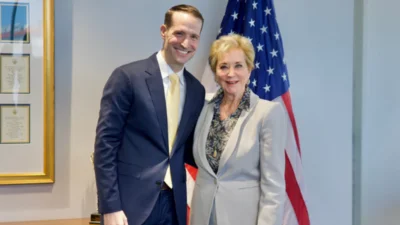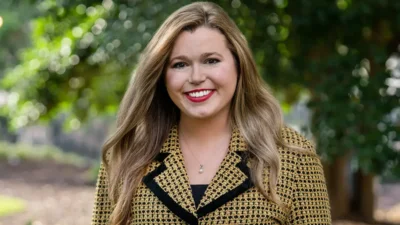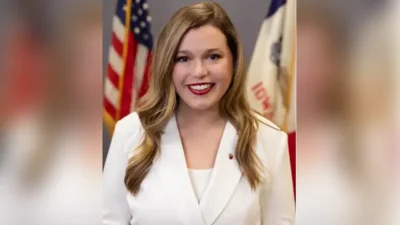Luther College Lutheran Church issued the following announcement on Dec. 1.
The renowned French filmmaker, Jean-Luc Godard, said, “Film is truth 24 times per second, and every cut is a lie.” Cinema possesses a strange power to spark insights by capturing truths and then reprocessing them in the forms of lies. Just think of how time-lapse cinematography in educational films illustrates the growth of a mushroom, the feeding habits of deep-sea sharks, the melting of glaciers, and more by revealing truths that happen over timescales we wouldn’t otherwise see. Film as truth is on my mind because on Monday, November 30, I started teaching my Film course and will get to know a cohort of Luther students as we explore this medium together. In this blog post, I’m going to visit three brief instances of film as truth.
Act One
Across this December and January, students and I will be thinking critically about film as a convergence of art, technology, industry, and telling a story. It’ll be my first time teaching Film fully within the pandemic. That said, in Spring 2020, a tenacious group of students completed a Science Fiction Film course with me that cut across the arrival of COVID-19 and the pivot to remote instruction. Poignantly, the first film of that course was Terry Gilliam’s 12 Monkeys, which follows humans in the future innovating time travel technologies to discern how most of our species was wiped out by a virus. In that course, we explored with a sense of genuine urgency the truths that science fiction film can tell as it juxtaposes potential futures with the present moment. In the Film course just getting underway now, we’ll examine cinema at a time of tremendous metamorphosis.
Nationwide, movie theatres have spent much of the past nine months shuttered or drawing in diminished spectators during their open phases. This is an important time to reflect on the experience and business of watching movies in theatres and to anticipate possible futures. The course will be a chance for students to think about the viability of these businesses, from small towns like Decorah to independent theatres in small cities and multiplex chains. We’ll talk about the unique power of screening a film in a crowded theatre as a unique blend of private and public--of feeling your own reactions to moments in a film and feeling social reactions when collective laughs or screams erupt.
There's magic in watching a film in an auditorium filled with people who are ostensibly strangers, yet you’ve all decided to take this journey together. In fact, if you’ve got a big screen memory you’d like to share, I’d love to read it in the comments here. I look forward to brainstorming together what may be gained and lost as the theatre experience metamorphosizes as well as what students imagine the experience could look like as it emerges from the pandemic cocoon. Will we see a more committed return of Drive-Ins, for example? It’s painful yet exciting to innovate when confronted with the necessity to do so.
Act Two
As a professor who regularly teaches film, I keep an eye on upcoming notable anniversaries. In 2021, a personal favorite turns 25 years old: Fargo, written and directed by Joel and Ethan Coen. I’m looking forward to investigating Fargo with students at Luther next year. For students from the upper midwest, the Coen Brothers’ film is a sort of cracked mirror that refracts as much as it reflects regional truths of how people talk, eat, and love their families. For students from outside the region, Fargo provides a chance to interrogate their own impressions of dialect, diet, values, and more. As a class group, we can bring these perspectives together to discuss the ethics, responsibilities, and ramifications of representation in this rare film about quotidian life in flyover America.
What’s more, Fargo invites us to triangulate regional representation with gender matters. In my experience, students get intrigued when you point out that it’s not until 30 minutes into a 90-minute film that Chief Marge Gunderson is introduced to the story. She’s a wonderful character. Chief Gunderson is an astute investigator, from crime scene reconstruction to various questionings and interrogations. We observe some of her family and home life, and her monologue to Gaear Grimsrud, the criminal she apprehended at Moose Lake, delivers a powerful ethical message. With Chief Gunderson and the other women in the film, the gender characterizations in Fargo call students and me to think hard together about how this, and other films, expand upon and/or rehearse familiar representations of women on the screen.
Act Three
Within the last week an unexpected box showed up on my doorstep. Inside was a movie premiere gift set, the sort of thing you might get as a Kickstarter reward for supporting an independent project.
The sender? Four of the most memorable students I’ve worked with at Luther College: Liam Fraser, Tad Guy, Andrew Murray, and Timothy Radermacher.
The occasion? In December they’re premiering online a film they made together, a project that began during their time at Luther and that they’ve seen through after graduating and taking disparate paths.
From my perspective, the completion and premiere of the film documents both the deep and meaningful friendships they forged during their studies and the joys of bringing their areas of expertise together to create a collective experiment.
I strongly suspect their classmates remember this group very well too. Liam, Tad, Andrew, and Timothy were all enrolled in the same section of my Film class—essentially the same course I’m teaching again over the next two months. A key assignment in that course was a group film project in which students cultivated teamwork capacities while applying the formal and technical elements we’d analyzed in other films to planning and producing their own short. This student foursome created a kind of screwball thriller about the gritty underworld of grilled cheese delivery services at Luther College. Carefully planned and executed, their film wowed their classmates, and me, and solicited excited applause when the end credits rolled. The ending, by the way, was shot in a defunct jail cell in Decorah because this group of students were so committed to their project that they reached out to the local Police Department to ask if there was a jail facility they could use for a filming location. They had a vision, and they realized it.
Now, I eagerly await the premiere of their new film, Dr. Feelgood and the Asparagus Kid; or, The Respect for the Omnipresence of Death.
I haven’t seen it yet. I don’t know what it’s like or about. I don’t know who’d find it appealing, so I can’t make a blanket recommendation for every potential spectator.
But what I do know is: whether checking out their film interests you or not, I hope you’ll join me in celebrating the fact that a group of friends who bonded at Luther continues finding truths in film. Truths of friendship, creativity, collaboration, and the persistence to dream and complete a project over years. These are truths that get us through difficult times such as those through which we’re now treading.
Post Script: One day after finishing this post, I hiked the newly opened Carlson Park in Decorah with my partner and our daughters, and we found one of the painted “Decorah Rocks” rocks carefully placed on a tree branch. In red font atop a brown base and coated in sparkly glaze, the rock declared, “i do marathons…(on netflix).” The film truth in me finding that rock provided the whole family a good laugh and me with a post-credits coda.
Original source: https://www.luther.edu/ideas-creations-blog/?story_id=930024




 Alerts Sign-up
Alerts Sign-up